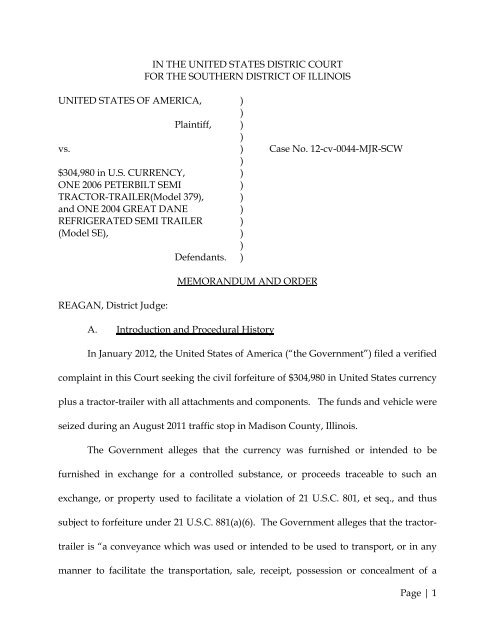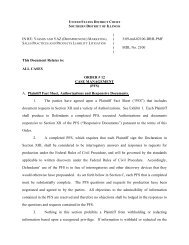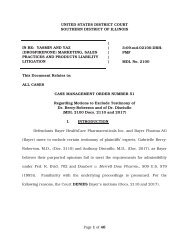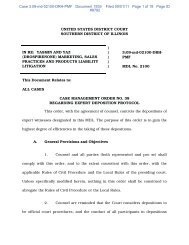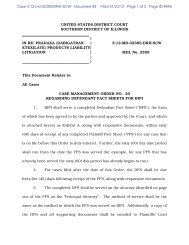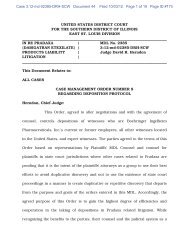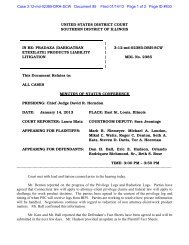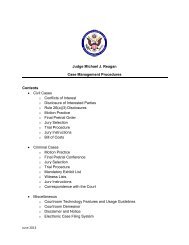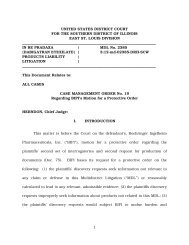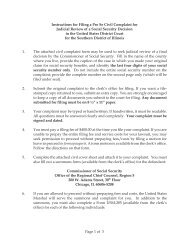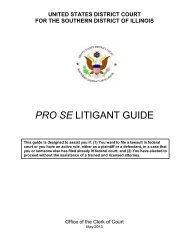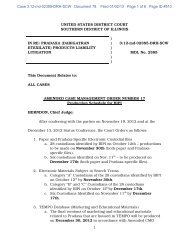Page | 1 IN THE UNITED STATES DISTRIC COURT FOR THE ...
Page | 1 IN THE UNITED STATES DISTRIC COURT FOR THE ...
Page | 1 IN THE UNITED STATES DISTRIC COURT FOR THE ...
You also want an ePaper? Increase the reach of your titles
YUMPU automatically turns print PDFs into web optimized ePapers that Google loves.
<strong>IN</strong> <strong>THE</strong> <strong>UNITED</strong> <strong>STATES</strong> <strong>DISTRIC</strong> <strong>COURT</strong><br />
<strong>FOR</strong> <strong>THE</strong> SOU<strong>THE</strong>RN <strong>DISTRIC</strong>T OF ILL<strong>IN</strong>OIS<br />
<strong>UNITED</strong> <strong>STATES</strong> OF AMERICA, )<br />
)<br />
Plaintiff, )<br />
)<br />
vs. ) Case No. 12-cv-0044-MJR-SCW<br />
)<br />
$304,980 in U.S. CURRENCY, )<br />
ONE 2006 PETERBILT SEMI )<br />
TRACTOR-TRAILER(Model 379), )<br />
and ONE 2004 GREAT DANE )<br />
REFRIGERATED SEMI TRAILER )<br />
(Model SE), )<br />
)<br />
Defendants. )<br />
REAGAN, District Judge:<br />
MEMORANDUM AND ORDER<br />
A. Introduction and Procedural History<br />
In January 2012, the United States of America (“the Government”) filed a verified<br />
complaint in this Court seeking the civil forfeiture of $304,980 in United States currency<br />
plus a tractor-trailer with all attachments and components. The funds and vehicle were<br />
seized during an August 2011 traffic stop in Madison County, Illinois.<br />
The Government alleges that the currency was furnished or intended to be<br />
furnished in exchange for a controlled substance, or proceeds traceable to such an<br />
exchange, or property used to facilitate a violation of 21 U.S.C. 801, et seq., and thus<br />
subject to forfeiture under 21 U.S.C. 881(a)(6). The Government alleges that the tractor-<br />
trailer is “a conveyance which was used or intended to be used to transport, or in any<br />
manner to facilitate the transportation, sale, receipt, possession or concealment of a<br />
<strong>Page</strong> | 1
controlled substance” (Complaint, Doc. 2, p. 3), rendering the tractor-trailer forfeitable<br />
under 21 U.S.C. 881(a)(4).<br />
Two claims were filed to contest the forfeiture -- one by Randy Davis, a<br />
commercial truck driver who was the sole occupant of the truck when it was stopped<br />
on Highway 70; the other by Randy’s wife, Delores Davis. The Davises claim that they<br />
lawfully own the tractor-trailer and the money found inside the sleeping compartment<br />
of the truck. The Davises filed a verified answer with their claims on February 2, 2012.<br />
Discovery proceeded, and a bench trial is scheduled to commence on April 8, 2013,<br />
following a March 22, 2013 final pretrial conference.<br />
In September 2012, the Davises filed a motion to suppress evidence. 1 After the<br />
motion was fully briefed, the undersigned Judge conducted an evidentiary hearing on<br />
December 19, 2012. Analysis of the motion begins with an overview of the key facts, as<br />
taken from the record before the court, including the exhibits to Doc. 21 (filed under<br />
seal) and the evidence adduced at the hearing.<br />
B. Summary of Facts<br />
Around 2:15 pm on August 26, 2011, two Task Force Officers (TFOs) with the<br />
United States Drug Enforcement Administration (DEA) – Kevin Thebeau and Derek<br />
Hoelscher – were patrolling Interstate 70 in unincorporated Madison County, Illinois, as<br />
part of a drug interdiction detail. Thebeau has worked as a DEA TFO for five years and<br />
1 The Davises’ motion (filed as a combined motion and supporting memorandum)<br />
does not specifically identify the evidence sought to be suppressed, i.e., the currency, the<br />
tractor-trailer, or both. The arguments contained in the motion and the<br />
arguments/evidence presented by the Davises at the December 19, 2012 hearing focused<br />
on suppression of the currency.<br />
<strong>Page</strong> | 2
has 24 years of experience in law enforcement, the bulk of which was as a patrol officer<br />
for the Granite City (Illinois) Police Department. Hoelscher has been a TFO for four and<br />
a half years and served as a police officer with the O’Fallon (Illinois) Police Department<br />
prior to being deputized as a DEA TFO.<br />
On August 26, 2011, Officer Thebeau was driving a white Ford Expedition and<br />
had parked the vehicle in the highway median near the 24-mile marker of I-70, facing<br />
east, from which vantage point Thebeau and Hoelscher could watch both eastbound<br />
and westbound traffic. Thebeau saw a blue 2006 Peterbilt tractor-trailer about a quarter<br />
of a mile to the east of his spot. The Peterbilt was headed westbound, appearing to<br />
travel the speed limit. At some point shortly thereafter, the officers pulled out and<br />
began driving the same direction.<br />
Meanwhile, in the 2006 Peterbilt, Randy Davis had heard radio chatter indicating<br />
that an “SUV cop” was “on the roll” and “wanted to get by.” Davis activated his turn<br />
signal to move his rig to the right. The truck to his right opened a gap allowing Davis<br />
to move into the lane to his right. Davis slid his Peterbilt into the space between the<br />
other vehicles and continued driving.<br />
Both Thebeau and Hoelscher observed that the blue Peterbilt was following quite<br />
closely behind another Peterbilt tractor-trailer in the driving or slow lane. The officers<br />
made this determination visually and using the “three-second rule” (a standard they<br />
typically used when gauging whether a vehicle was traveling at a safe distance behind<br />
other vehicles). As Thebeau described it, he picked a fixed point, watched the blue<br />
Peterbilt pass that point, and counted using 1000s (i.e., one-thousand-one, one-<br />
<strong>Page</strong> | 3
thousand-two, et seq.), to see how quickly the vehicle passed the fixed spot. Using this<br />
method, Thebeau calculated that the blue tractor-trailer was following in less than a<br />
two-second interval. From his training and experience, Thebeau concluded that<br />
Thebeau was following the semi in front of him too closely. This conclusion was<br />
buttressed by Hoelscher, who visually observed that the distance between the two<br />
vehicles was too short to allow the blue Peterbilt to safely stop, given the speed of the<br />
vehicles and the traffic conditions.<br />
The officers activated their lights and stopped the blue Peterbilt near mile marker<br />
21 (actually pulling over on the westbound ramp of I-70, a safer spot for the traffic stop).<br />
The name on the truck cab said Randy Davis. The officers ran the information through<br />
a computerized law enforcement database, and the tractor came back registered to<br />
Delores Davis.<br />
Thebeau approached the passenger side of the Peterbilt with Hoelscher directly<br />
behind him. Stepping up on the stair of the rig, Thebeau spoke to the driver through<br />
the passenger window, which the driver had lowered. Thebeau advised the driver<br />
(Randy Davis) the reason for the traffic stop and requested a driver’s license and vehicle<br />
documents, including a log book and bill of lading. Davis said he was the owner of the<br />
trucking company, and this was his only truck. When asked how business was going,<br />
Davis responded that it was not very good due to the fuel prices. When asked what he<br />
was hauling, Davis said he was empty, because he had just dropped off a load in<br />
Vandalia, Illinois. When asked for the bill of lading, Davis said he left it in Vandalia (or<br />
<strong>Page</strong> | 4
mailed it back to the shipper from Vandalia) and was en route to St. Louis, Missouri to<br />
pick up a load.<br />
Officer Thebeau advised Davis that he would be issued a warning citation for the<br />
traffic violation of following another vehicle too closely. Taking the documents,<br />
Thebeau returned to the squad car to write the warning. Thebeau reviewed the log<br />
book. It showed Davis traveling between Nogales, Arizona and Chicago, Illinois. The<br />
logbook also showed Davis had dropped off a load in Chicago on August 24, 2011, then<br />
traveled empty to Dearborn, Michigan where he picked up a load headed to Missouri.<br />
What he was hauling on that trip was not listed, and the log book became illegible after<br />
that point. The log book indicated that Davis had been off work 24 days in July 2011<br />
and another 15 days so far in August 2011.<br />
The significant amount of time off work struck the officers as suspicious for a<br />
truck driver who earns money only when hauling a load, especially a one-man trucking<br />
operation. Also perceived as odd was the fact that Davis had talked about business<br />
being bad, but his truck had brand new tires and expensive chrome parts. The officers’<br />
records query had not located any criminal history on Randy Davis, but Hoelscher<br />
learned from EPIC (El Paso Intelligence Center in Texas) that Davis’ truck was on a<br />
“watch,” and that he had been involved in criminal activity in the past. The officers<br />
decided to seek consent to search the tractor-trailer.<br />
The officers re-approached the Peterbilt and asked Davis to exit the vehicle.<br />
Davis complied, climbed out of the vehicle, and (out of habit) locked the tractor-trailer<br />
as he walked around the front and joined the officers on the passenger side.<br />
The<br />
<strong>Page</strong> | 5
officers gave Davis the traffic citation and explained it did not require a court<br />
appearance, and no “points” would appear on Davis’ driving record, as the ticket was<br />
simply a warning. They then asked Davis several additional questions. Davis denied<br />
carrying anything illegal in the truck, such as marijuana or cocaine. When asked<br />
whether there was a large amount of money in the truck, Davis also said no.<br />
While Hoelscher, Thebeau, and Davis were standing together next to the<br />
passenger door of the tractor, Thebeau asked Davis if he would consent to a search of<br />
the vehicle. Davis flatly denies this, but according to both Thebeau and Hoelscher<br />
(whose testimony the Court credits), Davis readily agreed. Thebeau testified that he<br />
could not recall the precise words Davis used, but Thebeau only asked once, and Davis<br />
immediately and unequivocally said yes or “go ahead.” Thebeau then handed Davis a<br />
written consent-to-search form, the top half of which was completed (see Doc. 15-1).<br />
Thebeau asked Davis to read and sign the form. Thebeau turned to enter the cab.<br />
Davis tried to manually open the passenger door for Thebeau, to allow Thebeau<br />
to get in the cab. The door was locked. Thebeau either said he would go around to the<br />
driver’s side or started to walk around to the driver’s side, at which time Davis used the<br />
keyless remote and unlocked the door for Thebeau. Thebeau entered the cab of the<br />
tractor-trailer and began searching.<br />
Standing outside the passenger side of the cab with Davis, Officer Hoelscher<br />
watched Davis reading the written consent-to-search form. According to Hoelscher,<br />
Davis’ demeanor changed as he read the form. He asked Hoelscher what the officers<br />
were looking for; Hoelscher said large quantities of illegal drugs or U.S. currency.<br />
<strong>Page</strong> | 6
Davis then looked at Hoelscher’s badge, which said O’Fallon Police Department. Davis<br />
asked Hoelscher about O’Fallon being in Missouri (puzzled as to why Hoelscher would<br />
be patrolling an Illinois highway). Hoelscher explained that he was an O’Fallon Illinois<br />
officer but was deputized to work with the DEA Task Force. Hoelscher produced his<br />
Task Force credentials for Davis. Davis asked what would happen if he did not sign the<br />
form. Hoelscher indicated they would probably radio for a narcotics detection K9 unit.<br />
Because Davis still had not signed the written form and appeared reluctant to do<br />
so, Hoelscher asked Davis if he was having trouble understanding the form. Davis did<br />
not answer. Hoelscher (who wanted to be sure everyone was “on the same page”)<br />
yelled to Thebeau to stop searching, because “Mr. Davis doesn’t want to sign the form.”<br />
Thebeau stopped searching. Thebeau stuck his head out of the window of the<br />
cab. Thebeau asked Davis if they still had his oral consent to search. Davis did not say<br />
yes or no, but he immediately “grabbed” the form from Hoelscher (“ripped the paper”<br />
out of Hoelscher’s hands by one account), signed two words on the signature line,<br />
initialed beneath the signature line, and returned the form to Hoelscher. (Both Thebeau<br />
and Hoelscher testified that Davis also said “I’ll sign it” as he snatched the consent form<br />
from Hoelscher’s hands. Davis denies saying “I’ll sign it.”) The officers did not<br />
scrutinize the form, assuming Davis signed his name. Hoelscher put the form away. It<br />
is undisputed that the officers did not again look at the form for several days.<br />
Although the officers thought Davis had signed his first and last name, he had<br />
actually signed the words “Under Protest” on the signature line and initialed below it.<br />
He did not advise the officers that he was signing under protest, did not tell them to not<br />
<strong>Page</strong> | 7
search, and did not say he was withdrawing his oral consent or limiting the scope of his<br />
oral consent. He did not try to block or prevent any part of the search.<br />
Significantly, when Thebeau resumed the search, Davis exhibited normal<br />
demeanor and engaged in friendly conversation with Officer Hoelscher. At some point<br />
standing outside the tractor-trailer, Davis told Hoelscher that years earlier he had been<br />
stopped in Texas and wrongfully arrested for possessing 200 pounds of marijuana. 2<br />
Davis thought the officers already knew that he had “been in trouble” before.<br />
Thebeau had searched other Peterbilt tractors and was familiar with the layout of<br />
the typical sleeping area. The sleeping area of Davis’ tractor was inconsistent with<br />
other Peterbilt tractors he had seen. Thebeau lifted the mattress and saw a large piece<br />
of plywood covered in black material. When Thebeau lifted the plywood, which was<br />
hinged on the back, he saw Ziploc freezer bags full of large stacks of United States<br />
currency, rubber-banded together. 3<br />
Thebeau described the space under the plywood (which was surrounded by<br />
aluminum tubing rails installed on the sheet metal at the base of the bed) as a “nonfactory<br />
void between the bottom of the mattress and the floor of the tractor which could<br />
conceal large amounts of currency [or] illegal narcotics” (Doc. 21-23, p. 5).<br />
2 Testimony at the suppression hearing varied as to the chronological sequence<br />
reflected in Officer Hoelscher’s Declaration provided in response to the suppression<br />
motion (Doc. 21-25, p. 3). When Davis told the officers about the Texas traffic stop and<br />
seizure is irrelevant to the Court’s analysis and resolution of the suppression motion.<br />
3 The currency was found to total $304,980.<br />
<strong>Page</strong> | 8
Davis was taken into custody and later released. The tractor-trailer and currency<br />
were seized. The Government filed this civil forfeiture proceeding, and the Davises<br />
filed claims, asserting that the currency and tractor-trailer belong to them.<br />
The Government served special interrogatories upon Randy and Delores Davis<br />
(“Claimants”), pursuant to Rule G(6)(a) of the Supplemental Rules for Admiralty or<br />
Maritime Claims and Asset Forfeiture Actions. Claimants responded. Claimants also<br />
filed the suppression motion now before the Court.<br />
In their suppression motion, Claimants deny that Randy Davis committed any<br />
traffic violation, deny that Randy consented to the search of the truck, argue that Randy<br />
actively resisted the search, and argue that Officer Thebeau “dismantled” the bed to<br />
find the currency (see, e.g., Doc. 15, p. 4 and p. 15), thereby exceeding the scope of any<br />
consent given. As explained below, the evidence belies this characterization and fails to<br />
support Claimants’ suppression arguments. The Court finds that the officers conducted<br />
a proper traffic stop, that Davis provided valid oral consent to search, that Thebeau<br />
merely raised the plywood sheet and saw the currency in the bin under the mattress,<br />
and this did not exceed the scope of the consent Davis voluntarily, knowingly gave.<br />
C. Overview of Civil Forfeiture<br />
Civil forfeiture proceedings are governed by statute, by the Federal Rules of Civil<br />
Procedure, and by the Supplemental Rules for Admiralty or Maritime Claims and Asset<br />
Forfeiture Actions (the latter referred to in this Order simply as “Supplemental Rules”).<br />
21 U.S.C. 881 declares certain property subject to forfeiture by the United States. The<br />
United States Attorney General may elect to seek criminal forfeiture under 18 U.S.C. 982<br />
<strong>Page</strong> | 9
or civil forfeiture under 18 U.SC. 983. See United States v. $133,420 in U.S. Currency,<br />
672 F.3d 629, 634 (9 th Cir. 2012).<br />
Criminal forfeitures operate in personam against the defendant and serve as a<br />
penalty upon conviction. By contrast, civil forfeitures operate in rem against the<br />
property itself, “under the theory that the property is guilty of wrongdoing.” See U.S.<br />
v. Duboc, 694 F.3d 1223, 1228 (11 th Cir. 2012). As one treatise summarized: “civil<br />
forfeiture is an in rem proceeding directed against the property itself …, while criminal<br />
forfeitures are in personam…. [I]n a civil forfeiture proceeding, the property owner’s<br />
culpability is not considered in determining whether the property should be forfeited.<br />
U.S. v. Cherry, 330 F.3d 658 (4 th Cir. 2003); Vereda, Ltda. v. U.S., 271 F.3d 1367 (Fed. Cir.<br />
2001). While a conviction is necessary to uphold a criminal forfeiture, conviction is<br />
irrelevant in a civil forfeiture proceeding. U.S. v. One Piper Aztec F De Lux Model 250 PA<br />
23 Aircraft, 321 F.3d 355 (3d Cir. 2003).” 3 Crim. Prac. Manual § 107.4 (2012).<br />
21 U.S.C. 881 provides, inter alia, for the forfeiture to the United States of<br />
property used in the commission of federal controlled substance violations punishable<br />
by more than one year in prison. See United States v. Real Property Located at 15324<br />
County Hwy E, 332 F.3d 1070, 1072 (7 th Cir. 2003). One subsection, § 881(a)(6), provides<br />
for forfeiture of money or things of value furnished or intended to be furnished in<br />
exchange for a controlled substance, all proceeds traceable to such an exchange, and all<br />
moneys used or intended to be used “to facilitate any violation of this subchapter.” In<br />
other words, § 881(a)(6) authorizes the civil forfeiture of any property derived from the<br />
proceeds of a drug transaction, traceable to the transaction, or intended to be used to<br />
<strong>Page</strong> | 10
facilitate a controlled substance offense.<br />
Another subsection, § 881(a)(4), authorizes<br />
forfeiture of vehicles used or intended for use to transport or conceal controlled<br />
substances.<br />
In a civil forfeiture proceeding, the government bears the burden of establishing<br />
by a preponderance of the evidence that the property is subject to forfeiture. If the<br />
government’s theory is that the property was used to commit or facilitate the<br />
commission of a criminal offense, the government must establish that there was a<br />
substantial connection between the property and the offense.<br />
The Seventh Circuit has explained the civil forfeiture provision of the Controlled<br />
Substances Act, 21 U.S.C. 881(a)(6), as follows:<br />
Civil forfeiture standards are now subject to the Civil Asset Forfeiture<br />
Reform Act of 2000 (“CAFRA”), 18 U.S.C. § 983(c)(1). CAFRA heightens<br />
the government's evidentiary burden in civil forfeitures - the government<br />
must demonstrate by a preponderance of the evidence that the property<br />
sought is subject to forfeiture. See id…. Furthermore, § 983(c)(3) provides<br />
that “if the Government's theory of forfeiture is that the property was<br />
used to commit or facilitate the commission of a criminal offense, or was<br />
involved in the commission of a criminal offense, the Government shall<br />
establish that there was a substantial connection between the property and<br />
the offense.” Id.<br />
United States v. Funds in Amount of Thirty Thousand Six Hundred Seventy Dollars,<br />
403 F.3d 448, 454 (7 th Cir. 2005). So, the Court pointed out in Thirty Thousand Six<br />
Hundred Seventy Dollars, a claimant’s “cash hoard may be subject to forfeiture if the<br />
currency at issue represents the proceeds of an illegal drug transaction or was intended<br />
to facilitate such a transaction.” Id., 403 F.3d at 454.<br />
<strong>Page</strong> | 11
District Courts enjoy original subject matter jurisdiction over civil forfeiture<br />
proceedings via 28 U.S.C. 1345 and 1355.<br />
See, e.g., United States v. Marrocco, 578 F.3d<br />
627, 632 n.3 (7 th Cir. 2009); United States v. Tit’s Cocktail Lounge, 873 F.2d 141, 142 (7 th<br />
Cir. 1989)(per curiam). Venue lies, inter alia, under 28 U.S.C. 1395, which includes “any<br />
district where such property is found.”). See 21 U.S.C. 881(j).<br />
D. Analysis of Suppression Motion<br />
→<br />
PRELIM<strong>IN</strong>ARY ISSUE<br />
One issue not briefed by the parties but bearing mention is the preliminary<br />
question of whether a Fourth Amendment-based suppression motion is proper in an in<br />
rem civil forfeiture proceeding like the case at bar. The federal courts have not<br />
answered this question uniformly. Some Courts of Appeal have held that since civil<br />
forfeiture proceedings are quasi-criminal in nature, the exclusionary rule applies, and<br />
suppression motions may be filed. See, e.g., U.S. v. $291,828.00 in U.S. Currency, 536<br />
F.3d 1234, 1236-38 (11 th Cir. 2008)(“The Fourth Amendment exclusionary rule applies<br />
to civil forfeiture actions.”); U.S. v. $493,850.00 in U.S. Currency, 518 F.3d 1159,<br />
1164 (9 th Cir. 2008)(“The exclusionary rule applies in civil forfeiture cases…. It bars<br />
the admission of evidence obtained in violation of the U.S. Constitution, as well as<br />
‘fruits of the poisonous tree.’”). Other courts have voiced uncertainty about the use of<br />
suppression motions in civil forfeiture actions. A 2009 Seventh Circuit case furnishes an<br />
example.<br />
In United States v. Marrocco, 578 F.3d 627, 631 n.5 (7 th Cir. 2009), the Court of<br />
Appeals for the Seventh Circuit sidestepped the potential obstacle, because the<br />
<strong>Page</strong> | 12
Government had not argued that the remedy of suppression is unavailable in forfeiture<br />
proceedings under 21 U.S.C. 881. However, in his concurring opinion, Judge<br />
Easterbrook expressed concern with the assumption that suppression motions are<br />
appropriate in civil forfeitures:<br />
All parties assume that the exclusionary rule applies to forfeiture, so<br />
that the res must be returned if it was improperly seized. Yet the<br />
Supreme Court has twice held that the exclusionary rule is not used in<br />
civil proceedings. See <strong>IN</strong>S v. Lopez–Mendoza, 468 U.S. 1032 … (1984)<br />
(deportation); United States v. Janis, 428 U.S. 433 … (1976) (taxation). See<br />
also Pennsylvania Board of Probation & Parole v. Scott, 524 U.S. 357 …<br />
(1998)(rule inapplicable to probation revocation). Although One 1958<br />
Plymouth Sedan v. Pennsylvania, 380 U.S. 693, 85 S.Ct. 1246, 14 L.Ed.2d 170<br />
(1965), suppressed evidence in a forfeiture, Janis stated that this was<br />
because that forfeiture was intended as a criminal punishment. 428 U.S. at<br />
447 n. 17…. The forfeiture in our case is civil. It is farther from a criminal<br />
prosecution than is a probation-revocation proceeding.<br />
Suppressing the res in a civil proceeding, even though the property is<br />
subject to forfeiture, would be like dismissing the indictment in a criminal<br />
proceeding whenever the defendant was arrested without probable cause.<br />
The Supreme Court has been unwilling to use the exclusionary rule to<br />
“suppress” the body of an improperly arrested defendant…. Why then<br />
would it be sensible to suppress the res?<br />
Marrocco, 578 F.3d at 642 (emphasis added).<br />
Similarly, the District Court for Northern District of Illinois has pointed out:<br />
The Supreme Court has suggested that, barring “egregious” Fourth<br />
Amendment violations, the exclusionary rule does not apply in civil<br />
proceedings. See Krasilych v. Holder, 583 F.3d 962, 967 (7 th Cir.<br />
2009)(citing <strong>IN</strong>S v. Lopez-Mendoza, 468 U.S. 1032, 1050-51 … (1984)). The<br />
primary purpose of the exclusionary rule is to deter unlawful police<br />
conduct. Courts have generally held that application of the exclusionary<br />
rule to criminal trials alone creates an adequate deterrent; any marginal<br />
benefit gained by extending the exclusionary rule to civil proceedings<br />
tends to be outweighed by the social cost of losing probative evidence. See<br />
generally United States v. Janis, 428 U.S. 433 … (1976).<br />
<strong>Page</strong> | 13
The exclusionary rule seems particularly ill-suited to civil forfeiture<br />
proceedings, where it is a physical object, not a person, that is the<br />
defendant.<br />
United States v. Funds in the Amount of $239,400, -- F. Supp. 3d --, 2012 WL 2007025, *6<br />
(N.D. Ill. 2012).<br />
The undersigned shares Judge Easterbrook’s reservations regarding the use of<br />
exclusionary rule-based suppression motions in civil forfeiture proceedings. However,<br />
here, as in Marrocco, the Government has not argued that suppression motions are<br />
unavailable in civil forfeitures. And the Seventh Circuit has not squarely held the<br />
exclusionary rule inapplicable to such proceedings. So the undersigned will reach the<br />
merits of Claimants’ Fourth Amendment challenge, analyzing the three components of<br />
the challenge (the traffic stop, the existence of a consent, and the scope of the consent)<br />
after addressing whether Claimants have standing to context the seizure of the res<br />
herein.<br />
→<br />
<strong>THE</strong> DAVISES HAVE STAND<strong>IN</strong>G<br />
In a civil forfeiture proceeding, a claimant must satisfy two separate thresholds<br />
of standing: (1) statutory standing, and (2) constitutional standing. See, e.g., United<br />
States v. U.S. Currency in the Amount of $103,387.27, 863 F.2d 555, 561 n.10 (7 th Cir.<br />
1988). To have statutory standing, a claimant must file a verified claim outlining his<br />
interest in the property within certain specified time limits. The filing of a proper claim<br />
is “an essential element of … standing to contest [a] forfeiture.” United States v. U.S.<br />
Currency in the Amount of $2,857.00, 754 F.2d 208, 215 (7 th Cir. 1985).<br />
As the Third Circuit succinctly stated:<br />
<strong>Page</strong> | 14
In order to stand before a court and contest a forfeiture, a claimant must<br />
meet both Article III and statutory standing requirements. To establish<br />
statutory standing in a forfeiture case, the claimant must comply with the<br />
procedural requirements set forth in Rule C(6)(a) and § 983(a)(4)(A)….<br />
The most significant requirement is that the claimant must timely file a<br />
verified statement of interest, as required by Rule C(6)(a).<br />
United States v. $487,825.00 in U.S. Currency, 484 F.3d 662, 664 (3 rd Cir. 2007).<br />
Constitutional or “Article III” standing requires an individual to have a sufficient<br />
interest in the property to contest the forfeiture. United States v. Stokes, 191 Fed.<br />
Appx. 441, 444 (7 th Cir. 2006).<br />
Under Article III of the United States Constitution,<br />
federal judicial power extends only to cases or controversies. Generally, to establish<br />
standing, plaintiffs must show (a) they suffered an injury in fact, (b) there is a causal<br />
connection between the injury and the conduct complained of, and (c) it is likely the<br />
injury will be redressed by a favorable decision. Lujan v. Defenders of Wildlife, 504<br />
U.S. 555, 560-61 (1992). See also G & S Holdings, LLC v. Continental Cas. Co., 697 F.3d<br />
534, 540 (7 th Cir. 2012)(To establish a case or controversy, the party seeking relief in<br />
federal court must demonstrate “a personal injury fairly traceable to the … allegedly<br />
unlawful conduct and likely to be redressed by the requested relief.”).<br />
Claimants in civil forfeiture actions “can satisfy this test by showing that they<br />
have ‘a colorable interest in the property,’ … which includes an ownership interest or a<br />
possessory interest.” United States v. $133,420 in U.S. Currency, 672 F.3d 629, 637-38<br />
(9 th Cir. 2012). “Article III’s standing requirement is thereby satisfied because an owner<br />
or possessor of property that has been seized necessarily suffers an injury that can be<br />
redressed at least in part by the return of the seized property.” Id., quoting United<br />
<strong>Page</strong> | 15
States v. $515,060.42, 152 F.3d 491, 497 (6 th Cir. 1998). See also United States v. 5 South<br />
351 Tuthill Road, Naperville, Illinois, 233 F.3d 1017, 1023 (7 th Cir. 2000)(claimant in a<br />
civil forfeiture proceeding has constitutional standing if he as an actual stake in the<br />
outcome of the proceedings).<br />
In other words, to demonstrate Article III standing in a civil forfeiture action, “a<br />
claimant must have ‘a sufficient interest in the property to create a case or<br />
controversy.’” United States v. Real Property Located at 475 Martin Lane, Beverly<br />
Hills, CA, 545 F.3d 1134, 1140 (9 th Cir. 2008). This is not a heavy burden at the initial or<br />
pretrial stage of a civil forfeiture action. The claimant need only demonstrate a<br />
colorable interest in the property, for instance, by showing actual possession, control,<br />
title, or financial stake. Id.<br />
Here, Randy and Delores Davis have shown constitutional (Article III) standing.<br />
They meet the test of possession of the currency at the time of the seizure, plus a claim<br />
of ownership of the currency. 4 This is sufficient to establish Article III standing at this<br />
stage of the proceedings. See $133,420 in U.S. Currency, 672 F.3d at 638 (“The fact that<br />
property was seized from the claimant’s possession, for example, may be sufficient<br />
evidence, when coupled with a claim of ownership, to establish standing” at the<br />
pretrial motion phase).<br />
The Court also finds that Claimants have satisfied the requirements of statutory<br />
standing. Their judicial claims sufficiently comply with the Supplemental Rules.<br />
4 Again, the Court notes that although Claimants’ arguments center on standing to<br />
contest seizure of the currency and do not directly address the tractor-trailer and its<br />
components, the undersigned’s standing analysis applies to all property seized.<br />
<strong>Page</strong> | 16
Randy and Delores Davis assert that they are the owners of the tractor-trailer and seized<br />
currency. These items were seized from Randy Davis, who at all times told the police<br />
he was the owner of the property. Randy Davis’ name was painted on the cab of the<br />
tractor-trailer. Delores Davis is the registered owner of the tractor-trailer. Both Randy<br />
and Delores Davis assert that they are owners, not just possessors, of the currency.<br />
Although the Government contests whether the Davises have fully and thoroughly<br />
responded to discovery requests, the record indicates that the Davises have participated<br />
in discovery, have responded to interrogatories, and have not invoked the Fifth<br />
Amendment in response to any inquiries. Finding that Claimants have shown both<br />
constitutional and statutory standing, the Court turns to the merits of the suppression<br />
motion.<br />
→<br />
<strong>THE</strong> TRAFFIC STOP WAS PROPER<br />
Claimants argue that there was no actual traffic violation and thus no reason to<br />
support the traffic stop in the first instance. This argument is a nonstarter.<br />
An officer has probable cause for a traffic stop whenever he has an objectively<br />
reasonable basis to believe a traffic law has been breached. United States v. Dowthard,<br />
500 F.3d 567, 569 (7 th Cir. 2007). Even a minor violation of a traffic law suffices, and the<br />
actual motivation of the police officer generally bears no weight on the constitutional<br />
reasonableness of the stop. United States v. Smith, 668 F.3d 427, 430 (7 th Cir.), cert.<br />
denied, 132 S. Ct. 2409 (2012), citing Whren v. United States, 517 U.S. 806, 819 (1996).<br />
Accord United States v. Garcia-Garcia, 633 F.3d 608, 612 (7 th Cir. 2011)(“When a police<br />
officer reasonably believes that a driver has committed even a minor traffic offense,<br />
<strong>Page</strong> | 17
probable cause supports the stop;” and the “officer’s subjective beliefs are largely<br />
irrelevant to the probable cause inquiry.”); United States v. Taylor, 596 F.3d 373, 377<br />
(7 th Cir.)(“Under current Supreme Court law, then, the subjective motivations of the<br />
agents are irrelevant to the Fourth Amendment analysis.”), cert. denied, 130 S. Ct. 3485<br />
(2010).<br />
The officer’s belief that a law has been broken must be reasonable. Smith, 668<br />
F.3d at 430. The evidence before this Court amply supports the conclusion that Officers<br />
Thebeau and Hoelscher reasonably believed Davis had violated a traffic law, specifically<br />
that he had been following another vehicle too closely – a violation of 625 ILCS 5/11-<br />
710(a), which prohibits following “another vehicle more closely than is reasonable and<br />
prudent, having due regard for the speed of such vehicles and the traffic upon and the<br />
condition of the highway.” Thus, probable cause supported the traffic stop of Davis’<br />
2006 Peterbilt tractor-trailer, and Claimants’ first argument for suppression fails.<br />
→<br />
RANDY DAVIS ORALLY CONSENTED TO <strong>THE</strong> SEARCH<br />
Claimants’ next argument for suppression – that Randy Davis never consented to<br />
the search of the tractor-trailer -- fares no better.<br />
The Fourth Amendment protects individuals against unreasonable searches and<br />
seizures. United States v. Jackson, 598 F.3d 340, 346 (7 th Cir.), cert. denied, 131 S. Ct.<br />
435 (2010). As a general rule, a search or seizure is per se unreasonable within the<br />
meaning of the Fourth Amendment unless it is supported by a warrant. Id. One wellrecognized<br />
exception to this general rule applies when a person consents to a search.<br />
Id., citing United States v. James, 571 F.3d 707, 713 (7 th Cir. 2009). The Government<br />
<strong>Page</strong> | 18
ears the burden of proving consent by a preponderance of the evidence. Jackson, 598<br />
F.3d at 346, citing Bumper v. North Carolina, 391 U.S. 543, 548 (1968).<br />
Of course,<br />
consent must be voluntarily given, a determination which depends on the totality of the<br />
circumstances. United States v. Hicks, 650 F.3d 1058, 1064 (7 th Cir. 2011), citing<br />
Schneckloth v. Bustamonte, 412 U.S. 218, 222 (1973).<br />
Here, Claimants (at least as to their primary argument presented in the motion<br />
and at the hearing) do not assert that consent was involuntary. Rather, they maintain<br />
that Randy Davis never consented to the search of his vehicle at all.<br />
However, the<br />
record before the Court (including the documentary evidence, and the in-court<br />
testimony of Randy Davis, TFO Hoelscher, and TFO Thebeau) plainly contradict this<br />
contention.<br />
Having observed and heard all three witnesses’ accounts of the traffic stop, the<br />
Court credits the officers’ testimony that Randy Davis, after being issued a traffic<br />
warning and denying that he was carrying any illegal drugs or large amounts of<br />
currency, orally consented to a search of his tractor-trailer. 5 Both officers recalled that<br />
oral consent was readily and quickly given, after Davis was asked only one time.<br />
Neither officer remembered the exact wording, but both described it as verbal consent<br />
given with no hesitation, something along the lines of “yes” or “yes, go ahead.”<br />
5 The Court finds the testimony of Officers Thebeau and Hoelscher credible. Each<br />
officer’s testimony was consistent with the other’s, and they were sequestered during the<br />
hearing. Their testimony did not appear rote or rehearsed. The officers made direct eye<br />
contact with the undersigned Judge, exhibited no furtive conduct while testifying, did<br />
not “over sell” their account of events, did not engage in guess, speculation or conjecture,<br />
and were forthright about details they could not recall. Moreover, their testimony made<br />
sense when considered in the context of all the surrounding circumstances and evidence.<br />
<strong>Page</strong> | 19
The oral consent was freely and voluntarily given. Davis was not in custody<br />
when he consented. The consent was given during an amenable, conversational<br />
exchange. The officers never harangued, threatened, or badgered Davis; nor did they<br />
draw their weapons or intimidate him to obtain the consent. Thebeau asked if he could<br />
search, and Davis immediately answered in the affirmative.<br />
Randy Davis’ other actions are consistent with consent having been given. He<br />
attempted to manually open the door for Thebeau. When that failed, Davis used his<br />
keyless remote to unlock the door for Thebeau. While Thebeau was searching the<br />
vehicle, Davis never spoke up to say he had changed his mind, that he wanted the<br />
search to stop, or that he was withdrawing the oral consent to search. In fact, when<br />
Officer Hoelscher observed non-verbal reluctance or indecision on Davis’ part as to<br />
signing the written consent form Davis had been asked to sign, it was Hoelscher (not<br />
Davis) who asked Thebeau to stop the search so they could be sure they were all still<br />
“on the same page.”<br />
Moreover, when Thebeau flatly asked if he still had Davis’ consent to search,<br />
Davis grabbed the written consent form from Hoelscher’s hands, signed two words on<br />
the signature line in cursive, initialed beneath those two words, and gave the paper<br />
back to Hoelscher – another indication that he agreed to the search of his rig. If Davis<br />
truly wanted to revoke his initial oral consent, it makes no sense that he failed to avail<br />
himself of the multiple opportunities he was given to do so.<br />
All he had to do was<br />
speak up, clarify that there was a misunderstanding and he had never really consented,<br />
tell the officers he had changed his mind and wanted to withdraw his consent, or alert<br />
<strong>Page</strong> | 20
the officers that he had written Under Protest on the signature line, not his name.<br />
Instead, he pretended to sign the form and then stood by as the search resumed. That is<br />
not consistent with withdrawing or revoking a consent. The consent was valid.<br />
→<br />
<strong>THE</strong> SEARCH DID NOT EXCEED <strong>THE</strong> SCOPE OF DAVIS’ CONSENT<br />
As the United States Supreme Court has held: “The scope of a search is generally<br />
defined by its expressed object.” Florida v. Jimeno, 500 U.S. 248, 251 (1991). Therefore,<br />
when a person with actual or apparent authority consents to a general search, “law<br />
enforcement may search anywhere within the general area where the sought-after item<br />
could be concealed.” Jackson, 598 F.3d at 348-49.<br />
In the case sub judice, Claimants contend that if Randy Davis orally consented to<br />
the search, then his signing of the written form “Under Protest” limited the scope of the<br />
permitted search, because it constituted an express rejection of the language on the form<br />
permitting the search of “constructed compartments.” Claimants also suggest that the<br />
search exceeded the scope of any oral consent because “the discovery of the currency<br />
required the dismantling of the bed compartment, ‘a vehicle component’ as<br />
contemplated in the language of the rejected consent form” (Doc. 15, pp. 10-11). These<br />
arguments are wholly devoid of merit.<br />
The Court has found that Randy Davis voluntarily and knowingly furnished oral<br />
consent to search the tractor-trailer. Nothing in the record before the Court supports<br />
the conclusion that Davis attempted to limit the scope of the search (or withdrew his<br />
consent to search). When Davis hesitated to sign the written consent form, Officer<br />
<strong>Page</strong> | 21
Hoelscher advised Officer Thebeau that Davis had not signed the form. Officer Thebeau<br />
then stopped the search and point-blank asked if he still had Davis’ verbal consent.<br />
Davis’ response was to grab the form and pretend to sign it. By Davis’ own account, he<br />
never declared that he was signing under protest, never told them to stop searching,<br />
never said he was withdrawing his consent, and never set the officers straight if (as he<br />
claimed) he had never consented in the first place. He signed the form on the signature<br />
line and stood by, chatting with Officer Hoelscher, while Officer Thebeau resumed the<br />
search. This does not constitute a limitation on the scope of the search to which Davis<br />
consented.<br />
That is especially true here, where Davis had been expressly told that the officers<br />
were looking for drugs or currency. The compartment under his mattress (accessed by<br />
simply lifting up the plywood, without any “dismantling,” without the use of tools, and<br />
without destroying or damaging the structure) obviously could hold drugs or money.<br />
Indeed, it held nearly $305,000 in currency, which the record suggests Davis knew was<br />
there and likely gambled or hoped the officers would not discover.<br />
Five months ago, the Seventh Circuit upheld against a constitutional challenge a<br />
much more intrusive search in United States v. Saucedo, 688 F.3d 683 (7 th Cir. 2012), a<br />
case with striking factual similarities to the case now before this Court. In Saucedo, the<br />
Illinois State Police had stopped a Peterbilt tractor-trailer for a traffic violation (the<br />
registration plate appeared to have expired). A trooper advised the driver of the<br />
Peterbilt (Saucedo) of the reason for the traffic stop, asked for his paperwork (logbook,<br />
driver’s license, etc.), and ultimately asked Saucedo whether he had any weapons,<br />
<strong>Page</strong> | 22
marijuana or cocaine in the tractor-trailer. Saucedo said he did not. The trooper asked<br />
if he could search the tractor-trailer, and Saucedo replied, “yes.”<br />
Spotting what he thought was an alteration to a small alcove that housed a<br />
compartment in the bunk area behind the driver’s seat, the trooper used a flashlight and<br />
a screwdriver to remove one screw and pull back the plastic molding around the alcove.<br />
When he peered inside, the trooper saw a hidden compartment.<br />
The trooper then<br />
removed the 3 remaining screws from the molding, took out the hidden compartment<br />
from the alcove, opened it, and found 10 kilograms of cocaine. Seeking to suppress the<br />
cocaine, Saucedo claimed that the trooper had exceeded the scope of the consent given.<br />
The Seventh Circuit rejected this argument and affirmed the denial of the suppression<br />
motion.<br />
The Court reiterated the standard for measuring the scope of a consent under the<br />
Fourth Amendment – an objective standard which asks what a typical reasonable<br />
person would have understood by the exchange by the police officer and the person<br />
who consented. Saucedo, 688 F.3d at 865. The Seventh Circuit then emphasized:<br />
“When a person is informed that an officer is looking for drugs in his car<br />
and he gives consent without explicit limitation, the consent permits law<br />
enforcement to search inside compartments and containers within the car,<br />
so long as the compartment or container can be opened without causing<br />
damage.” United States v. Calvo-Saucedo, 409 Fed. Appx. 21, 24 (7 th Cir.<br />
2011). And as the Supreme Court explained, “[a] reasonable person may<br />
be expected to know that narcotics are generally carried in some form of<br />
container. Contraband goods rarely are strewn across the trunk or floor of<br />
a [vehicle.]” Jimeno, 500 U.S. at 252….<br />
So Saucedo was well aware that [Trooper] Miller was looking for drugs.<br />
And Saucedo gave his consent to search without any express limitation.<br />
Thus, his consent allowed Miller to search inside compartments in the<br />
<strong>Page</strong> | 23
tractor-trailer, including in the sleeper area, where drugs could be<br />
concealed. This necessarily included the hidden compartment, which one<br />
could reasonably think might, and in fact did, contain drugs.<br />
Saucedo, 688 F.3d at 866.<br />
Applying the same rationale to the facts before this Court, the undersigned Judge<br />
concludes that Randy Davis’ general oral consent to search, given without any express<br />
restriction or limitation, given when Davis knew the officers were looking for currency,<br />
allowed TFO Thebeau to search under the mattress of the sleeping/bunk area of the<br />
2006 Peterbilt tractor-trailer. There is no evidence whatsoever that Davis ever<br />
articulated a limitation on the extent of the search. Even Davis himself concedes that<br />
he stood by while Thebeau searched the sleeping compartment and did not instruct the<br />
officer to stop searching. If Davis really intended to revoke his consent or limit the<br />
scope of his consent, he could and should have said so. He was not locked in a squad<br />
car; he was standing by his tractor-trailer right next to Hoelscher and within earshot of<br />
Thebeau. He had opened the door for Thebeau, and signed a form and handed it to<br />
Hoelscher without saying anything to indicate a limitation on the consent.<br />
The Court rejects outright the idea that signing the form with the words Under<br />
Protest in cursive on the signature line (but never alerting anyone to the fact he had<br />
done so) effectively limited the scope of the search. A reasonable person would have<br />
believed that Randy Davis, knowing full well that the officers were searching for<br />
currency, had consented to the search of his tractor-trailer, including the bunk area and<br />
compartment under the mattress.<br />
Simply put, officers conducting a consent search<br />
<strong>Page</strong> | 24
“may search anywhere within the general area where the sought-after item could be<br />
concealed.” Jackson, 598 F.3d at 348-49. Thebeau’s search did not exceed the scope of<br />
the general consent he had been given, and the search does not run afoul of the Fourth<br />
Amendment. Suppression is not warranted.<br />
E. Motion to Strike<br />
Also before the Court is the Government’s motion to strike claims and for<br />
judgment on the pleadings or summary judgment. That motion became ripe with the<br />
filing of a reply brief on December 14, 2012.<br />
The Government contends: (1) the<br />
Davises’ claims are inadequate to establish statutory standing to contest the forfeiture,<br />
so the Court should strike the claims and answers filed by the Davises and award<br />
judgment on the pleadings to the Government; or (2) if the Court finds that Claimants<br />
have shown statutory standing, summary judgment in favor of the Government is<br />
appropriate, because Claimants lack Article III standing to challenge this forfeiture.<br />
As the Court explained in its analysis above, statutory standing requires<br />
compliance with Supplemental Rule G(5)(a) and 18 U.S.C. 983(a)(4)(A). A claimant<br />
must file a proper claim on a timely basis, and the claim must identify the property<br />
claimant, identify the claimant’s interest in the property, be signed by the claimant<br />
under penalty of perjury, and be served on the Government in the manner set forth in<br />
the Supplemental Rules. Here, the Government concedes that Claimants filed their<br />
claims on a timely basis (Doc. 25, pp. 8-9) but insist that the claims set forth only bald<br />
assertions that the Davises are the lawful owners of the property. The Government also<br />
takes issue with the Davises’ dodgy and incomplete responses to interrogatories<br />
<strong>Page</strong> | 25
tailored to probe the specific details of the sources of the funds discovered in the<br />
tractor-trailer.<br />
The undersigned District Judge understands the Government’s frustration with<br />
the discovery responses, but a discovery-based motion is not before the Court, and this<br />
Judge has concluded that the Davises’ claims comply with the Rules and statute. Plus,<br />
the record contains more than a mere assertion of a possessory interest. The Davises<br />
themselves allege that they are the owners of the truck and the seized currency. It is<br />
undisputed that the items were seized from Randy Davis, that Randy Davis’ name was<br />
painted on the side of the truck, that the truck was registered to Delores Davis, and that<br />
the currency was in the exclusive possession of Randy Davis when seized. The Davises<br />
have statutory standing, and the Court declines to strike their claims and award<br />
judgment to the Government on this basis.<br />
Additionally, as explained in the analysis in Section D above, the Court has<br />
found that the Davises have shown constitutional or “Article III” standing.<br />
At this<br />
stage in the proceedings, a claimant satisfies this case-or-controversy requirement by<br />
demonstrating an unequivocal assertion of ownership of the property, such as the<br />
Davises have asserted here.<br />
Stated another way, the Davises meet the test of possession of the res at the time<br />
of seizure plus a claim of ownership of the currency, which generally suffices for Article<br />
III standing at the pretrial phase in a civil forfeiture case. See $133,420 in U.S. Currency,<br />
672 F.3d at 638 (“The fact that property was seized from the claimant’s possession, for<br />
example, may be sufficient evidence, when coupled with a claim of ownership, to<br />
<strong>Page</strong> | 26
establish standing” at the pretrial motion phase). Summary judgment, partial<br />
summary judgment, or judgment on the pleadings in favor of the Government is not<br />
appropriate on the record now before the Court. 6<br />
What the evidence at trial establishes as to the true source and proper disposition<br />
of the property is another issue entirely. The Davises appear to have dramatic financial<br />
problems, meager assets, and staggering liabilities post-bankruptcy, raising commonsense<br />
questions as to how they could have accumulated $305,000 in cash as of the date<br />
of the traffic stop (and be the lawful owners of the currency and tractor-trailer). But the<br />
Court finds that the Davises have standing to contest the forfeiture, and thus the Court<br />
DENIES the Government’s motion to strike, for judgment on the pleadings, or for<br />
summary judgment.<br />
F. Conclusion<br />
For all the reasons delineated above, the Court DENIES Claimants’ motion to<br />
suppress (Doc. 15) and DENIES the Government’s motion to strike, for judgment on<br />
the pleadings, or for summary judgment (Doc. 24). Bench trial remains set April 8,<br />
2013, with a final pretrial conference on March 22, 2013. Resolution of the suppression<br />
motion triggers the lifting of the discovery stay, pursuant to the terms of Magistrate<br />
Judge Williams’ Order (Doc. 20).<br />
6 The undersigned Judge is cognizant that discovery has not been completed<br />
herein, and in fact has been stayed pending resolution of the suppression motion. This<br />
case is procedurally unlike cases where summary judgment was properly granted in civil<br />
forfeiture proceedings after discovery was complete, a full record was before the court,<br />
and the claimant did not dispute the material facts presented by the Government in<br />
support of summary judgment. See, e.g., Thirty Six Thousand Six Hundred Seventy<br />
Dollars, 403 F.3d at 452-55.<br />
<strong>Page</strong> | 27
One other matter requires attention – the deadline for dispositive motions. A<br />
Scheduling and Discovery Order was not entered in this case originally. In is<br />
September 2012 Order staying discovery, Magistrate Judge Williams set broad<br />
parameters for a schedule, giving the parties 30 days to complete discovery and 60 days<br />
to file dispositive motions after the suppression motion was decided (see Doc. 20, p. 2).<br />
Five weeks later, the Government filed a dispositive motion, after which the<br />
undersigned District Judge entered a November 1, 2012 Order explaining that the<br />
Government’s motion rendered the January 2013 trial date then in place unworkable.<br />
The undersigned Judge continued the final pretrial and trial to the March 22, 2013 and<br />
April 8, 2013 dates, respectively, but pointed out that all dispositive motions typically<br />
must be filed 100 days prior to the commencement of trial, and thus (technically) the<br />
dispositive motion deadline had expired.<br />
In a brief supporting the Government’s motion to strike or for judgment on the<br />
pleadings/summary judgment, counsel declares that the “United States is … reserving<br />
… the right to file at a later date and after the completion of discovery, additional<br />
dispositive motions” (Doc. 25, p. 20). The problem is that such dispositive motions<br />
would not be able to be briefed and ruled on sufficiently in advance of the March final<br />
pretrial conference and April trial date, given this Judge’s docket. The undersigned<br />
District Judge, who sets and enforces firm trial dates, continued the trial once to permit<br />
a dispositive motion to be filed and does not intend to continue the trial a second time.<br />
Accordingly, the Court CLARIFIES that all dispositive motions must be filed no<br />
later than January 15, 2013, with responses filed by February 15, 2013. (The Clerk’s<br />
<strong>Page</strong> | 28
Office shall reflect this deadline in the cm/ecf system.) A 20-page limit applies to briefs<br />
supporting and opposing dispositive motions, no reply briefs will be permitted, and no<br />
extensions of these deadlines will be granted. This will barely give the Court time to<br />
rule on any motion prior to the March final pretrial conference.<br />
If the parties find this timeline burdensome and, understandably, wish to<br />
complete additional discovery prior to filing later dispositive motions, they are<br />
encouraged to consent to trial before the Magistrate Judge assigned to this case.<br />
Magistrate Judges typically enjoy a more flexible trial docket and can accommodate<br />
motions to continue trial much more easily than the undersigned. Consent forms may<br />
be obtained from the Clerk’s Office, found on the Court’s web page, or provided by<br />
Courtroom Deputy Debbie DeRousse at 618-482-9298. This option is offered only as an<br />
alternative. No adverse consequences will result from any party’s decision to decline to<br />
consent to trial before a Magistrate Judge.<br />
Finally, the undersigned hereby DIRECTS the parties to contact Judge Williams<br />
on or before January 18, 2013, to schedule a settlement conference sometime prior to the<br />
March final pretrial conference herein.<br />
IT IS SO ORDERED.<br />
DATED January 3, 2013.<br />
s/ Michael J. Reagan<br />
Michael J. Reagan<br />
United States District Judge<br />
<strong>Page</strong> | 29


